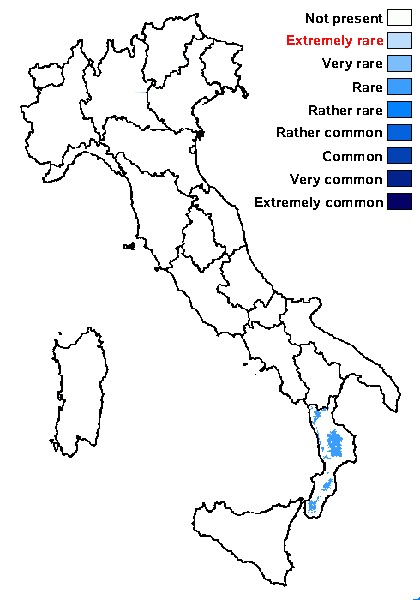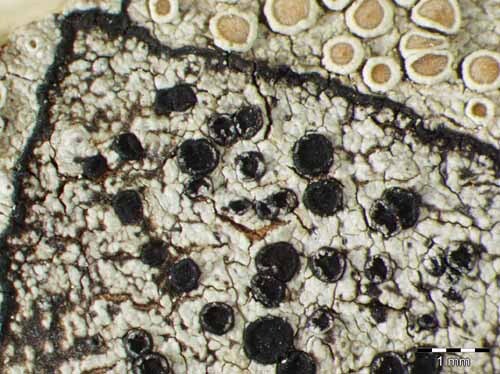Buellia iberica Giralt
in Giralt & Llimona, Mycotaxon, 75: 186, 2000.
Synonyms:
Distribution: S - Cal (van den Boom & Giralt 2002).
Description: Thallus crustose, episubstratic, whitish to whitish grey, thin, smooth to rimose, sometimes delimited by a dark prothallus. Medulla white, I-. Apothecia lecideine, black, (0.2-)0.3-0.4(-0.6) mm across, adnate to sessile, with a flat to slightly convex, epruinose disc, and an initially rather thick and prominent, later thinner, but rarely totally excluded proper margin. Proper exciple poorly developed, 30-40(-50) µm wide, brown to partly olivaceous, K+ yellow turning red (crystals) or K- (microscope slide), the hyphae rounded to elongate, rather thin-walled and more intensely coloured in the outermost part; epithecium brown to olivaceous; hymenium colourless, not inspersed with oil droplets, 60-80(-100) µm high; paraphyses c. 2 |µm thick at mid-level, the apical cells 3-4(-4.5) µm wide, with a brown cap; hypothecium with oil droplets. Asci 8-spored, clavate to cylindrical-clavate, the apical dome K/I+ dark blue with a pale, conical-pointed apical cushion (axial mass), the wall I-, but the thin outer gel I+ blue, Bacidia-type. Ascospores 1(-3)-septate, brown, ellipsoid with mostly pointed apices, usually curved, (15.5-)17-21(-23) x 7-10 µm, Callispora-type when young, Buellia-type when mature, with a faint microrugulate ornamentation and ontogeny of type A (apical wall thickenings produced after septum formation). Photobiont chlorococcoid. Spot tests: thallus K+ yellow or rarely K+ yellow-orange turning red, C-, KC-, P- or P+ yellow-orange. Chemistry, atranorin, with or without norstictic and connorstictic acids.Note: a recently-described, perhaps western species found on acid bark and lignum in upland areas; see also note on B. erubescens.
Growth form: Crustose
Substrata: bark and lignum
Photobiont: green algae other than Trentepohlia
Reproductive strategy: mainly sexual
Commonnes-rarity: (info)
Alpine belt: absent
Subalpine belt: very rare
Oromediterranean belt: absent
Montane belt: rare
Submediterranean belt: absent
Padanian area: absent
Humid submediterranean belt: absent
Humid mediterranean belt: absent
Dry mediterranean belt: absent

Predictive model
Growth form: Crustose
Substrata: bark and lignum
Photobiont: green algae other than Trentepohlia
Reproductive strategy: mainly sexual
Commonnes-rarity: (info)
Alpine belt: absent
Subalpine belt: very rare
Oromediterranean belt: absent
Montane belt: rare
Submediterranean belt: absent
Padanian area: absent
Humid submediterranean belt: absent
Humid mediterranean belt: absent
Dry mediterranean belt: absent

Predictive model
 INDEX FUNGORUM
INDEX FUNGORUM
 GBIF
GBIF


